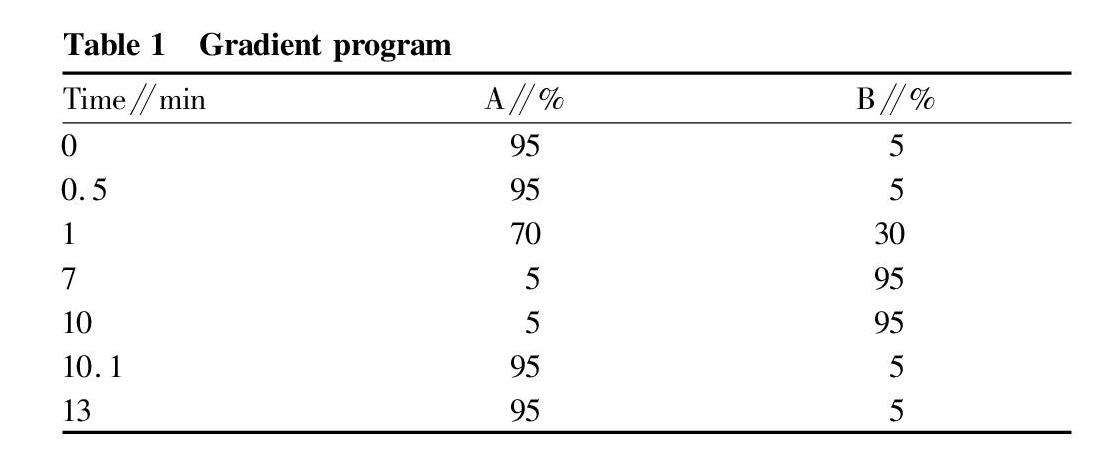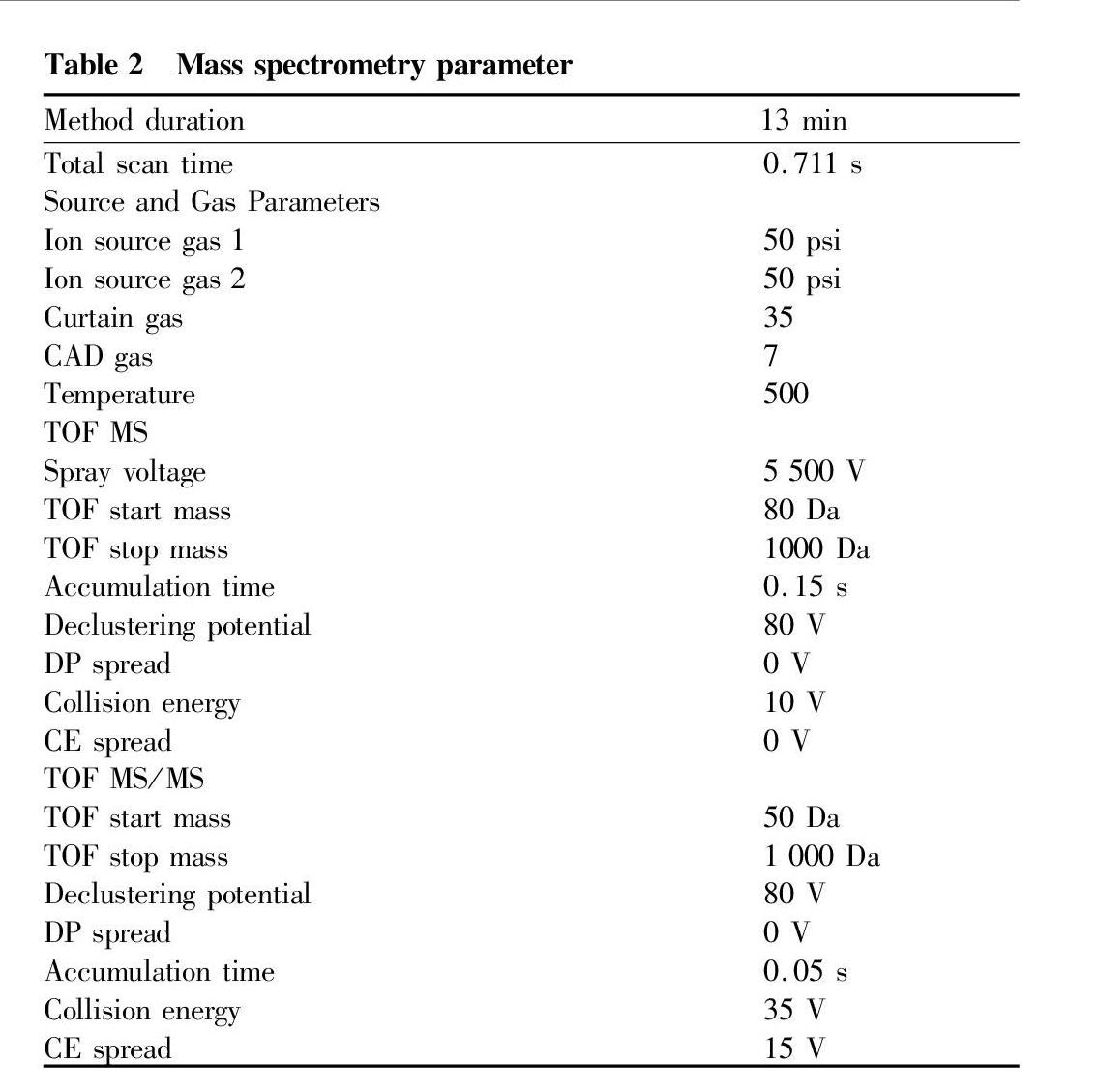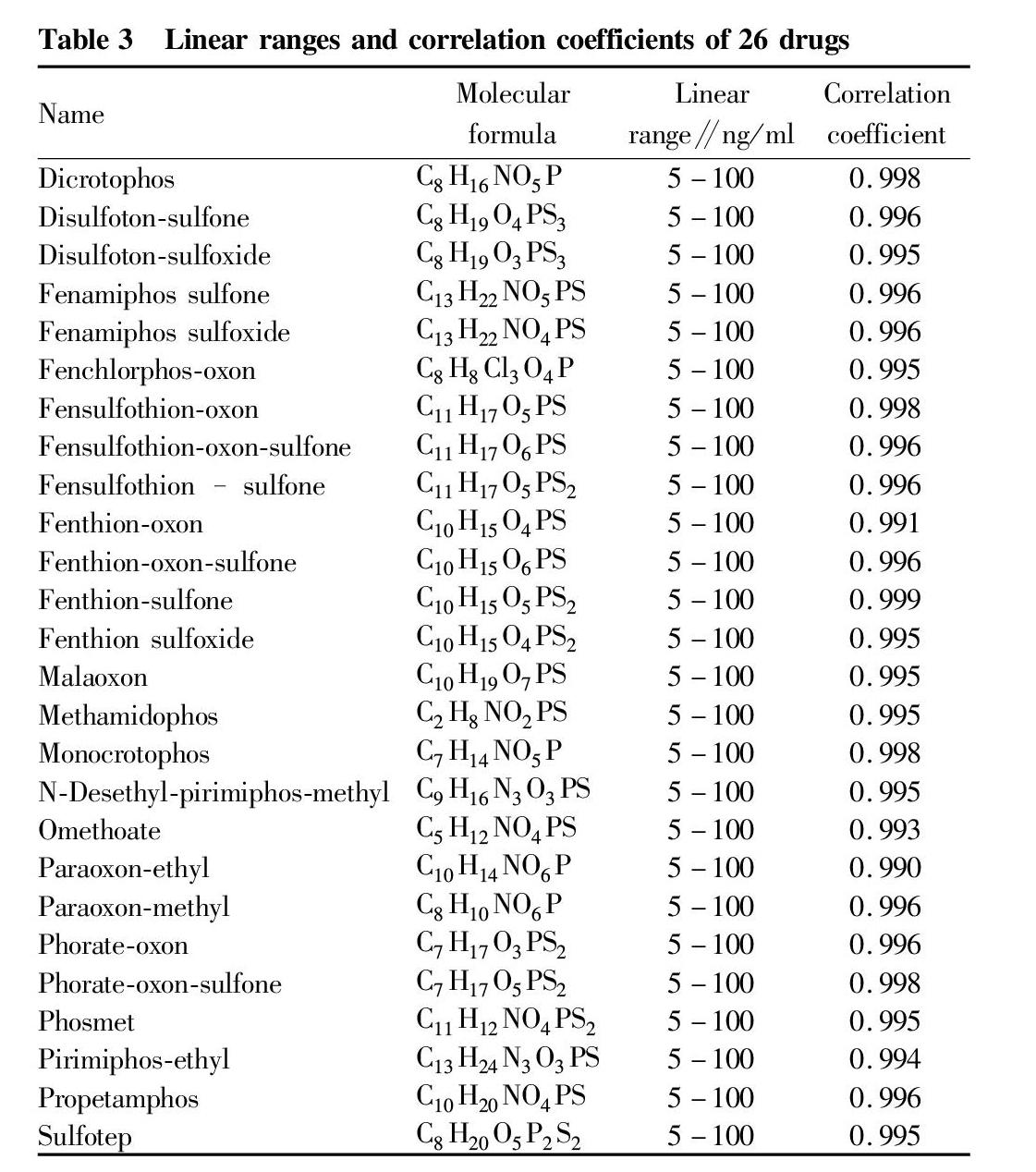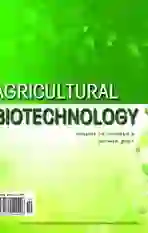Rapid Screening of 26 Organophosphorus Pesticides in Fresh Milk by Ultra Liquid Chromatography Coupled With Quadrupole-Time of Flight Mass Spectrometry
2021-11-02YiLILumanHUOLeiWANGLixueDONGAijunLIYiZHANGBaiqinZHENG
Yi LI Luman HUO Lei WANG Lixue DONG Aijun LI Yi ZHANG Baiqin ZHENG



Abstract [Objectives] A rapid screening and analysis method for 26 organophosphorus agrochemicals in fresh milk was established using ultra performance liquid chromatography coupled with quadrupole-time of flight mass spectrometry.
[Methods]Raw milk was extracted with acetonitrile solution containing 0.2% formic acid by volume, and purified with a Dikma ProElut QuECHERS solid phase extraction cartridge. Target compounds were separated on a Waters ACQUITY UPLC HSS T3 chromatographic column (2.1 mm×50 mm, 1.8 μm) with methanol-water solution as a mobile phase for gradient elution, and through scanning with an electrospray ion source in positive ion mode, 26 kinds of organophosphorus agrochemicals could be accurately qualitatively determined within 10 min.
[Results] When using formic acid acetonitrile with a volume fraction of 0.2%, there were more types of detected compounds and a greater recovery; and using B cartridge could effectively eliminate the interference of non-polar substances such as phospholipids, achieve higher number of detected compounds than those of A and C, and well separate the 26 kinds of agrochemical residues.
[Conclusions]This study provides a reference method for the rapid screening of agrochemical residues in dairy cows in the future.
Key words Ultra Liquid chromatography coupled with quadrupole-time of flight mass spectrometry (UPLC-Q-TOF-MS); Fresh milk; Organophosphorus agrochemicals; Rapid screening
Received: June 6, 2021 Accepted: August 9, 2021
Supported by Hebei Provincial Key R&D Project (19227516D); Hebei Provincial Phase II Modern Agricultural Industry Technology System Innovation Team Building Project (HBCT2018120207, HBCT2018160403).
Yi LI (1994-), male, P. R. China, pastors, devoted to research about animal nutrition.
Luman HUO (1991-), female, P. R. China, pastors, devoted to research about animal nutrition.
#These authors contributed equally to this work.
*Corresponding author.
Coarse fodder is one of the indispensable feed materials in the process of dairy cattle breeding, accounting for about 60% of dairy cows diet. The sources of agrochemical residues in raw milk are firstly produced by accumulation of coarse fodder containing agrochemical residues by dairy cows. Secondly, they are directly used for deworming or preventing diseases in dairy cows[1]. Therefore, it is of great significance to develop a rapid detection method for agrochemical residues in fresh milk.
Gao et al.[2] established an analysis method for 8 pyrethroid pesticides in milk by gas chromatography. Liu et al. established a method for the determination of 20 organochlorine agrochemical residues in milk by gas chromatography-tandem mass spectrometry. Leng et al.[3] established a gas chromatograph for the simultaneous determination of five organophosphorus agrochemical residues in milk, including trichlorfon, methamidophos, dichlorvos, malathion, and fenthion. At present, there are many domestic researches on the detection methods of agrochemical residues in fresh milk, mostly on GC methods, which can detect a small number of compounds, require longer pre-treatment time, and have a complicated pre-treatment process[4-6].
Ultra liquid chromatography coupled with quadrupole-time of flight mass spectrometry (UPLC-QTOF) has the advantages of high sensitivity and fast acquisition time. It can scan data with high quality, accuracy and speed, and there is no limit to the number of scanned compounds. Through accurate mass number and isotope peak shape and library matching, compounds can be qualitatively analyzed conveniently, quickly and accurately. In this study, a rapid screening method for agrochemical residue detection in milk was established by UPLC-QTOF technology, providing a reference method for the rapid screening of agrochemical residues in dairy cows in the future.
Materials and Methods
Instruments and reagents
Instruments
Ultra liquid chromatography coupled with quadrupole-time of flight mass spectrometry (X500R): AB SCIEX Company, USA; electronic balance (PL2002): Shanghai Mettler-Toledo Company; Vortex machine (MS3 basic): IKA Company, Germany; oscillator (heidolph): Heidolph, Germany; nitrogen blowing instrument, centrifuge.
Materials
Organophosphorus standards were purchased from Tianjin Alta Company (100 μg/ml); formic acid, methanol, and acetonitrile were MS pure, and other reagents were analytically pure; experimental water was distilled water (Watsons); fresh milk samples were collected from Tangshan City; 0.22 μm filter membrane was purchased from DIKMA; purification tube A: Cleanert MAS-Q was manufactured by Agela; purification tube B: Dikma ProElut QuECHERS was manufactured by Dikma; and purification tube C: QuECHERS dSPE EMR-Lipid was manufactured by Agilent.
Experimental methods
Preparation of standard stock solution and working solutions
Standard stock solution: First, 1 ml of mixed pesticide standard substance with a concentration of 100 μg/ml was drawn, and diluted to 10 ml with acetonitrile to obtain a mixed standard solution with a concentration of 10 μg/ml, which was stored in a refrigerator at -20 ℃.
Preparation of standard working solutions: The mixed standard working solutions of 0.005, 0.010, 0.020, 0.050, and 0.100 μg/ml were prepared, respectively. They should be used right after they are ready.
Sample preparation
A certain amount of liquid milk (2.00 g) was accurately pipetted into a 50.0 ml centrifuge tube, and added with 8 ml of 0.2% formic acid-acetonitrile solution. The mixture was vortex-mixed, shaken for 10 min, ultrasonically treated for 5 min, and then centrifuged at 8 000 r/min for 5 min. All the supernatant was transferred to a purification tube, vortex-mixed, shaken for 10 min, and then stood for 15 min. Next, 4 ml of the supernatant was accurately pipetted into a 10 ml centrifuge tube, blown with nitrogen to nearly dry, and diluted to 1.00 ml with 10% acetonitrile-water solution. The obtained solution was filtered with 0.22 μm filter membrane for later use.
Ultra liquid chromatography coupled with quadrupole-time of flight mass spectrometry
Liquid chromatography conditions were as follows: column: Waters ACQUITY UPLC HSS T3 (2.1 mm×50 mm, 1.8 μm); column temperature: 40 ℃; injection volume: 5 μl; flow rate: 0.3 ml/min. Mobile phases in positive ion mode: A was aqueous solution plus 5 mmol/L ammonium formate and 0.1% formic acid; and B was methanol solution plus 5 mmol/L ammonium formate and 0.1% formic acid. The acquisition time was 13 min, and the gradient program is shown in Table 1.
Mass spectrometry conditions were as follows: electrospray ion source (ESI), positive ion scan mode, and acquisition mode IDA. The specific parameters are shown in Table 2.
Results and Analysis
Standard curve
An appropriate amount of the mixed standard solution was accurately measured and diluted with acetonitrile to prepare mixed standard working solutions with concentrations of 5, 10, 20, 50, and 100 ng/ml, respectively. The concentrations were determined from low to high. The results are shown in Table 3.
Actual sample measurement results
A certain amount of fresh milk sample (2.00 g) was accurately drawn, added with 1.00 ml of 100 ng/ml standard solution, and pretreated according to the method of "Sample preparation". Each group of treatment included six samples, which were measured on the machine, and the data were subjected to targeted analysis. The 26 agrochemicals could be detected within 10 min. The total ion current diagram is shown in Fig. 1.
It can be seen from Table 4 that all 26 agrochemicals could be detected. The retention time was between 1.50-7.37 min, and the peak area was between 1.65E+04-1.75E+06. The Mass Error was between ±1.4 ppm, and the Library Score was greater than or equal to 89.6, which could meet the needs of rapid qualitative determination.
Conclusions and Discussion
Optimization of sample extraction method
The quality of sample pretreatment methods determined the success or failure of detection. During test processes, the sample pretreatment methods generally include extraction, centrifugation, concentration, purification and other steps. Different pretreatment methods will cause different test results. In this study, acetonitrile, 0.2% formic acid acetonitrile, and 2% formic acid acetonitrile were used as extraction solvents. The volume ratio of extraction solvent to sample was 4∶1, and the B purification tube was used for purification and extraction. The results showed that when using formic acid acetonitrile with a volume fraction of 0.2%, more compounds were detected and the recovery rate was greater.
Optimization of sample purification method
The contents of protein and non-polar phospholipid interference substances in raw milk are high, which is prone to matrix interference. Therefore, milk samples must be purified to reduce mechanism effects. In this study, three solid phase extraction cartridges A, B, and C were selected on the basis of original experiments. The results showed that the use of B cartridge could effectively remove the interference of non-polar substances such as phospholipids, and the number of detected compounds was higher than A and C, and the 26 kinds of agrochemical residues could be separated well.
In this study, we used 0.2% formic acid acetonitrile for extraction, and a B solid phase extraction column for purification, and combined with optimized pretreatment methods and high-resolution mass spectrometry technology, a rapid screening method for 26 organophosphorus drugs in fresh milk was established. Due to large quantitative error of liquid chromatography coupled with quadrupole-time of flight mass spectrometry, we mainly conducted rapid screening research, striving for accurate qualitative determination of a large number of compounds in a short time. The method is fast, simple, and sensitive, and can accurately qualitatively identify the 26 organophosphorus drugs within 60 min.
References
[1] ZHENG JH, PANG GF, FAN CL, et al. Simultaneous determination of 128 pesticide residues in milk by liquid chromatography-tandem electrospray mass spectrometry[J]. chinese Journal of Chromatography, 2009, 7(3): 254-263. (in Chinese)
[2] LIU Y, ZHENG GC, WANG J, et al. Determination of 20 organochlorine pesticides residues in milk by gas chromatography-tandem mass spectrometry[J]. Inspection and Quarantine Science, 2012, 22(4): 38-45. (in Chinese)
[3] LENG J, DENG B, LI QH, et al. Analysis of organophosphate pesticide residues in milk by gas chromatograph[J]. China Dairy Cattle, 2011(2): 57-60. (in Chinese)
[4] CHEN J, JIANG RQ, WEI WP, et al. Detection method of pesticide residues in raw milk by gas chromatography[J]. China Dairy Industry, 2013, 41(011): 38-40. (in Chinese)
[5] HAN JZ, TIAN XL, LI XZ, et al. Determination on 6 kinds of pesticide residues in the raw milk by ultra performance liquid chromatography-tandem mass spectrometry[C]∥ Liaoning Provincial Society of Animal Husbandry and Veterinary Medicine, 2014. (in Chinese)
[6] DAI YY, YAN L, WANG CT, et al. Determination of organochlorine pesticide residues in fresh milk by gas chromatography-electron capture detector[J]. China Dairy, 2018, 204(12): 66-68. (in Chinese)
杂志排行
农业生物技术(英文版)的其它文章
- Effects of Pruning Methods on the Growth and Development of New Shoots and Fruit Yield and Quality of Walnut
- Selection of Grape Varieties Suitable for Double Cropping a Year in Northern Greenhouse
- Effects of Uniconazole on Photosynthetic Characteristics of Dahlia pinnata Cav. under Drought Stress
- Community Structure and Value Evaluation of Local Brassicaceae Potherbs in Shiyan City
- Home Planting Techniques of Green and Healthy Rape Sprouts
- Research Progress of Polygonatum Germplasm Resources in China
